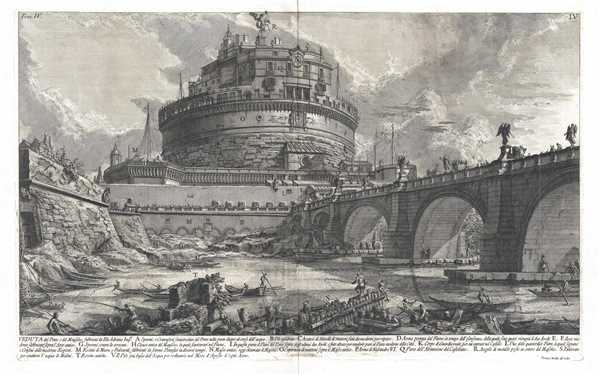This item has been sold, but you can get on the Waitlist to be notified if another example becomes available, or purchase a digital scan.
1756 Piranesi View of Rome, Italy (Castel Sant'Angelo)
VedutaPonteMauselo-piranesi-1756
Title
1756 (undated) 16 x 26 in (40.64 x 66.04 cm)
Description
The Castel Sant'Angelo was initially commissioned by Emperor Hadrian as a mausoleum for himself and his family. Hadrian's ashes were placed in the mausoleum following his death in 138, along with those of his wife and adopted son that same year. The ashes of succeeding emperors were also placed in the mausoleum, with Caracalla being the last recorded deposition in 217.
The Castel Sant'Angelo which stands in Rome today is not the same building which was constructed by the ancient Romans. The ashes of the emperors were lost during the sacking of Rome by the Visigoths in 410. The original decorative stone and bronze statuary were used against the attacking Goths when they laid siege to Rome in 537. Legend has it that, in the act of sheathing his sword, the Archangel Michael appeared atop the mausoleum as a sign of the end of the plague in 590, which is how the castle gained its current name. Other legends involving the Archangel and the castle also exist. Michael is the statue which appears at the top of the building in this view.
The popes, however, were the ones that converted the mausoleum in to a castle. Pope Nicholas III connected the castle to St. Peter's Basilica by a fortified corridor, and Pope Clement VII sought refuge there during Charles V's Sack of Rome in 1527. The Papal State also used Sant'Angelo as a prison and executions were performed in the small inner courtyard.
This view was produced by Giovanni Battista Piranesi in 1756 as part of his series Vedute di Roma published in Antichità Roma in volume four as plate number four.
Cartographer
Giovanni Battista Piranesi (October 4, 1720 - November 9, 1778) was an Italian artist famous for his etchings of Rome and fictitious ‘prisons’. He was born in Mogliano Veneto, which was part of the Republic of Venice. He learned his trade (Piranesi considered himself an architect) from his father, a stonemason and master builder, his uncle, who taught him structural and hydraulic engineering, an his brother, a Carthusian monk, who inspired Piranesi’s fascination with history and the ancient Romans.
After Piranesi arrived in Rome in 1740, he briefly served as an apprentice to Giuseppe Vasi, who is recognized as the foremost producer of etchings of Rome, meant for pilgrims, scholars, artists, and tourists alike. Creating etchings provided Piranesi with a way to satisfy all of his interests, from designing fantastically complex structures that could only exist in his imagination, to reconstructing the ruins of ancient Rome. His archaeological prints, published in his Antichità Romane in 1756, allowed him to be elected to the Society of Antiquarians in London. He began working on his best known works, the Vedute di Roma (Views of Rome) by 1747, and would continue adding to the series until his death in 1778.
Piranesi is also celebrated for his series known as The Prisons (Carceri d’invenzione, ‘Imaginary Prisons’). These are fantastic, labyrinthine structures of epic proportions. He began working on the series in 1745, and the first state prints, which included fourteen etchings, were published in 1750 and were untitled and unnumbered. The second publishing in 1761 was formatted differently. This series included sixteen etchings, all of this were reworked and numbered I-XVI (1-16). Numbers II and V were new to the series. Though the series remained untitled, each of the sixteen etchings now is attached to a ‘conventional’ title. More by this mapmaker...

